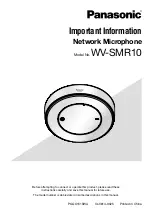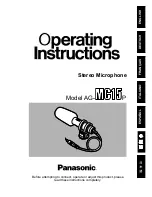
9
Certifications
Meets essential requirements of European R&TTE Directive 99/5/EC,
eligible to bear the CE mark:
WEEE Directive 2002/95/EC as amended by 2008/34/EC.
RoHS Directive 2002/95/EC as amended by 2008/35/EC.
Meets requirements of EMC standards EN 300 328, EN 300 422 Parts 1
and 2, and EN 301 489 Parts 1 and 9.
Certified under FCC Part 15 and FCC Part 74.
Certified in Canada by IC to RSS-123 and RSS-210.
This Class B digital apparatus complies with Canadian ICES-003.
Cet appareil numérique de la classe B est conforme à la norme NMB-
003 du Canada.
FCC ID:
DD4AXT200.
IC:
616A-AXT200.
Operation of this device is subject to the following two conditions: (1)
this device may not cause interference, and (2) this device must accept
any interference, including interference that may cause undesired
operation of the device.
The CE Declaration of Conformity can be obtained from Shure
Incorporated or any of its European representatives. For contact
information please visit www.shure.com
The CE Declaration of Conformity can be obtained from: www.shure.
com/europe/compliance
Authorized European representative:
Shure Europe GmbH
Headquarters Europe, Middle East & Africa
Department: EMEA Approval
Wannenacker Str. 28
D-74078 Heilbronn, Germany
Phone: +49 7131 72 14 0
Fax: +49 7131 72 14 14
Email: EMEAsupport@shure.de
Transmitter
AXT100 Bodypack
gain = 0dB
AXT200 Handheld
gain = 0dB
UR1 Bodypack
gain = 0dB
sens = 0dB
UR1M Bodypack
gain = 0dB
sens = 0dB
UR2 Handheld
gain = 0dB
Receiver
gain setting = 0dB
AXT400
+10dB gain
+15dB gain
+15dB gain
+15dB gain
+15dB gain
UR4
N/A
N/A
+18dB gain
+18dB gain
+18dB gain
System Gain
System gain from transmitter input to Receiver XLR output (line) when transmitter gain = 0 dB
Information to the user
This equipment has been tested and found to comply with the limits for
a Class B digital device, pursuant to Part 15 of the FCC Rules. These
limits are designed to provide reasonable protection against harmful
interference in a residential installation. This equipment generates uses
and can radiate radio frequency energy and, if not installed and used
in accordance with the instructions, may cause harmful interference to
radio communications. However, there is no guarantee that interference
will not occur in a particular installation. If this equipment does cause
harmful interference to radio or television reception, which can be
determined by turning the equipment off and on, the user is encouraged
to try to correct the interference by one or more of the following
measures:
• Reorient or relocate the receiving antenna.
• Increase the separation between the equipment and the receiver.
• Connect the equipment to an outlet on a circuit different from that to
which the receiver is connected.
• Consult the dealer or an experienced radio/TV technician for help.
Licensing Information
Licensing: A ministerial licence to operate this equipment may be
required in certain areas. Consult your national authority for possible
requirements.
Changes or modification not expressly approved by Shure Incorporated
could void your authority to operate the equipment. Licensing of
Shure wireless microphone equipment is the user’s responsibility, and
licensability depends on the user’s classification and application, and
on the selected frequency. Shure strongly urges the user to contact the
appropriate telecommunications authority concerning proper licensing,
and before choosing and ordering frequencies.






























